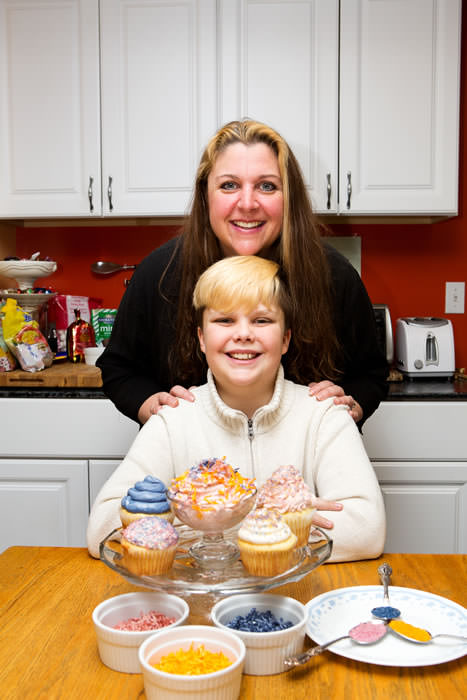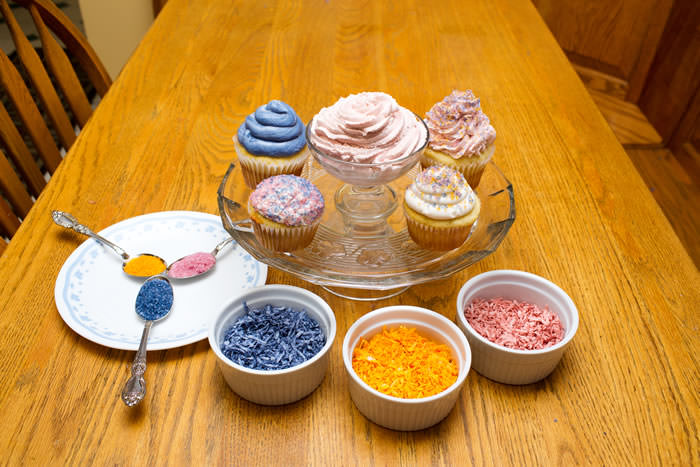edible nutrition
TOXIC COLORS
The FDA says food dyes are safe, but some studies paint a different picture.
WRITTEN BY SUE EDMONDSON
PHOTOS BY GINA MUNDA
Ever wonder why M&M’s and Froot Loops are rainbow colored? Or why farm-raised salmon are fed colorants to turn their flesh pink? There’s only one reason for all of this effort and expense, and it’s not to improve our health. It’s because palette matters to the palate.
Scientists suspect we can thank evolution for this phenomenon — early humans learned that brightly colored meat was fresh and safe to eat. Regardless of origin, studies conclusively show that color affects our perception of food flavor. Egyptians recognized the principle as early as 300 B.C. when they added color to wine, and it’s the reason 43 percent of foods marketed to children contain artificial dyes, according to the Center for Science in the Public Interest.
Government scrutiny
Food dyes have been regulated since enactment of the Pure Food and Drug Act of 1906. In fact, they were among the first items monitored as they often contained poisons and were used to disguise a product’s poor condition. Currently, nine artificial and 28 natural (plant-, mineral-, or animal-based) dyes are FDA approved. But does regulation equal safety?
Natural food dyes are widely considered safe, with a caveat: Some people may have allergies to particular dyes, especially those derived from insects. However, opinions are sharply divided on the safety of artificial dyes. One concern is that most testing for carcinogens and toxicity was done more than 50 years ago.
“At the time these dyes were tested, it was with the understanding they’d be consumed in small amounts,” says Truckee Meadows Community College dietetic nutrition professor and registered dietician Heather Williams. “Given the increase in the use and consumption of dyes, additional research is warranted.”
Delaney Battista, nutritional health coach at Natural Grocers in Reno, agrees.
“In the 1950s, people consumed an average of 12 milligrams of artificial dyes a day,” she says. “Now, according to studies, it’s more than 62 per day.”
It’s no surprise that our consumption of artificial dyes has dramatically increased — they’re heavily used in processed foods, even those you might not expect, such as pickles. Wash down a packet of Skittles (33.3 milligrams of dye) with a cherry-flavored Kool-Aid Burst (52.3 milligrams), and you’re well over the FDA estimated daily intake of 45 milligrams. Still, the FDA maintains this usage is safe as it falls well below the maximum acceptable daily intake for both children and adults, which is more than 1,000 milligrams.
“Like any food materials, some individuals may be sensitive to some of these items,” says Stanley Omaye, the University of Nevada, Reno department chair of Agriculture, Nutrition and Veterinary Sciences, and state nutrition specialist. “However, food colors are highly regulated and must meet safety standards based upon extensive toxicity testing. This is an old story, with little new evidence.”
In some ways, it is an old story. For example, the link between dyes and behavior problems in children has been studied for more than 35 years. Then, in 2007, a University of Southampton study successfully linked consumption of artificial food dyes to hyperactivity in some children. The findings were compelling enough to result in an FDA hearing in 2011. While the committee voted against banning dyes and requiring warning labels, it suggested further studies were warranted. A 2012 article published by the National Institutes of Health supports additional studies and states that dyes may be more of a threat to overall public health than suspected.

Case in point
Alex Bevans always was active. His kindergarten teacher thought he might have attention-deficit/hyperactivity disorder, but only some of the time.
“That didn’t make sense,” says his mother Rebecca Bevans, a Western Nevada College professor who has a Ph.D. in cognitive neuroscience and a master’s degree in human development. “You either have ADHD or you don’t.”
Her son’s busy behavior increased as he aged. By the time he was 7, he had difficulty concentrating and complained that his brain “buzzed.” Bevans put her research skills to work and found articles that linked hyperactivity to red dye No. 40. Things clicked when she read about a 15 year old who complained about brain buzzing after eating foods with the dye. Bevans eliminated it from Alex’s diet, and within a week, the buzzing stopped. Alex was less hyper and better able to concentrate.
“I thought we’d solved the problem,” Bevans says. “But a few months later, he started having meltdowns. Pretty soon, everything was a struggle. Then he started scratching at his arms and begging me to get him a knife so he could kill himself. All I could think is that we were going to lose him by the time he hit puberty. Suicide isn’t something 7 year olds talk about.”
The problem came to a head during a trip to Hawaii. Every day while there, Alex ate pineapple shaved ice, which was loaded with yellow dye. By the end of the trip, he was having two meltdowns a day. Bevans then eliminated all artificial dyes from his diet. It seemed to work. Alex is a healthy, successful youth, who eats every category of food (even junk food, to his mother’s dismay), all colored with natural dyes.
Through her outreach efforts, Bevans has discovered the problem is widespread.
“I advise any parent of a child with behavior problems to eliminate artificial food dyes in the child’s diet for two weeks. If a child is sensitive to dyes, it doesn’t take long for there to be a noticeable difference,” she says. “It takes effort to check with restaurants about their ingredients and to read labels — dyes are in toothpaste, mouthwash, and even children’s medication. But it’s well worth it. If you knew your child was diabetic, would you feed him handfuls of sugar? It’s the same thing.”
Dyes dying out?
A 2014 Nielsen survey of 30,000 consumers worldwide found that 42 percent of them deem the absence of artificial dyes in food extremely important. Companies are responding to concerns, and use of artificial dyes is declining, slowly. It can take years to reformulate products using natural dyes to match the appearance created by artificial ones. In the meantime, many experts suggest limiting consumption of these dyes.
“Many artificially colored foods are things we shouldn’t eat large amounts of anyway, like candy, sodas, and processed foods,” Williams says. “Why not gear ourselves toward consuming food with less additives in general, and look at food from a holistic perspective?”
Freelance writer Sue Edmondson enjoys experimenting in the kitchen. She recently discovered that turmeric makes anything it touches yellow, including white tennis shoes and her dog’s paws.
RESOURCES
Ready to go natural? Take these easy steps.
1. Read labels. Every food label contains a complete list of ingredients, including any dyes.
2. Get nutritional advice. Delaney Battista of Reno’s Natural Grocers offers free consultations and is knowledgeable about the potential impact of artificial food dyes.
3. For homemade goods, natural food dyes are available in packaged form at Reno’s Great Basin Community Food Co-op and Whole Foods Market. Or make your own with spices and foods. There’s a benefit to coloring with foods — Battista says they impart nutrient-dense phytochemicals. However, beware that when used in large quantities they may affect flavor, and some, such as ginger, are too strongly flavored to use at all, notes Linda Steck, owner of Natural Advantage Health Shoppe, herbalist and certified nutrition consultant. The store offers a selection of natural products suitable for use as food dyes.
4. Start with a fun family project — dyeing eggs for Easter or other occasions. Angela Keyser, marketing manager for High Quality Organics, offers step-by-step advice for using a variety of foods and spices (among them, avocado skins to make pink eggs). For details, visit Hqorganics.com/diy-all-natural-egg-dyes.
5. For additional information on dye-related issues, visit Rebecca Bevans’ website Livingdyefree.org. Be sure to watch her informative TEDx talk.
Making natural dyes
Making natural dyes is as easy as opening a spice jar or juicing raw fruits or vegetables. Jumpstart your project with these tips:
Start with small amounts of spices, herbs, or powders to avoid adding unwanted flavor to foods. A pinch or two of turmeric turns foods yellow, paprika makes them orange, and parsley or matcha powder can create a pastel green. For black, use activated charcoal powder. Cocoa, espresso, and instant coffee turn foods brown.
The juices of most fruits and vegetables turn foods the colors you’d expect — use beets, raspberries, or pomegranate for pink or red, carrots for orange, spinach for green, and grape juice for purple. There are exceptions: Red cabbage turns food blue and blueberries make them purple. A tablespoon of juice instead likely will do the trick.
Vegetable juices can turn brown in baked goods. Mixing in one part lemon juice, vinegar, or buttermilk to six parts juice solves the problem.


